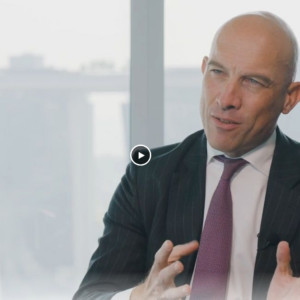
Chinese stocks have surged following the government’s abandonment of its lockdown policy and provided a shot in the arm to the whole region

Although there were some exceptions, notably India, 2022 was a difficult year for Asian equities. Although much of the region faced multiple headwinds, such as a slowing global economy and rising geopolitical tensions, it was China that attracted the most attention. So important to both the regional, and indeed global, economy, the country saw its stockmarket tumble as it persevered with stringent zero-Covid lockdown policy, as well as repercussions of a regulatory crackdown against internet companies and ongoing issues in its property market. Many investors were badly spooked.
But there has been a remarkable recent turnaround in sentiment towards China. “In October and November 2022, international investor sentiment towards China was the most pessimistic it had been in the past 20 years,” says Jian Shi Cortesi, investment director, Asia and China growth equities, at GAM Investments. “But now we are excited to talk to investors about China and Asia as an investment opportunity, particularly as clear signs of recovery have begun to emerge.”
The negative factors that punished Chinese and Asian equities last year have started to turn positive, she explains (see box on page 31), and despite a strong recovery, there are still opportunities to be found. With zero-Covid policies reversed, companies in the travel or sportswear sectors stand to benefit. “When Chinese consumers were surveyed about the three things they want to do the most following Covid, people said: exercise outdoors, travel and eat at restaurants,” says Ms Cortesi.
Misconceptions in the market could provide buying opportunities, she says, highlighting semiconductor names and technology hardware companies which may have bottomed out and are due a recovery. There has also been a slowdown in the renewables sector in Asia, says Ms Cortesi, for example in solar, where polysilicon prices have been falling, and she expects to be able to buy into some names at low prices.
Yet despite China’s reopening, and the undoubted boost to its economy, the country’s long-term gross domestic product (GDP) growth rate will continue to decline, cautions Ms Cortesi.
“In our view, China is now similar to a middle-aged person. Previously, China was a teenager that could grow fast, now it is a 30- to 40-year-old and cannot grow that fast. In the next 10 to 20 years, we expect Chinese GDP growth will trend toward 3 per cent, although this year we see a strong rebound because of Covid and because of the low base.”
Over the long-term, GDP growth will depend on industrial policy, she says. While a decade ago, China was making socks and shoes, it is now making computers, smartphones and electronic components.
“In the future, China will compete in higher-end products, such as medical devices, electric vehicles and clean energy products. As China moves up the value chain, that is where the next pillar of growth will come from,” adds Ms Cortesi.
Money to spend
China has accumulated more than $2.6tn in excess bank deposits over the Covid period, says Mike Kerley, portfolio manager, Asia-Pacific equities, at Janus Henderson Investors. “Although China is a nation of savers and these deposits are unlikely to be depleted quickly, a proportion is likely to be spent on the goods and services that they have been deprived of for three years,” he says, with the obvious beneficiaries being consumer discretionary sectors as well as travel and leisure.
The change in direction from
zero-Covid to pro-growth shows how the ruling Chinese Communist party has emphasised the importance of the private sector in providing growth and jobs, says Mr Kerley, which could mean a resurgence of the tech sector.
“With youth unemployment at just over 16 per cent, the technology and internet sectors are key to the success of the private sector. Now the regulatory lines have been drawn on what the government expects from the internet sector going forward, the period of peak regulation and interference has passed.”
The disruption to supply chains caused by the Covid-19 pandemic, along with rising geopolitical tensions, have emphasised the need for a more diversified approach to the supply of goods. While many companies were overreliant on China in the past, this trend should benefit other Asian economies, such as Vietnam, Indonesia and India.
“China is too integral to the production of most goods to be replaced,” says Mr Kerley. “But at the margin, multinational companies are seeking other sources of supply to reduce concentration risk.”
Willing workers
Asia’s abundance of low-cost labour, along with both a skilled and semi-skilled workforce, offers manufacturers looking to diversify supply chains many choices within the region, says Sundeep Bihani, portfolio manager, Asia equities, at Eastspring Investments.
“The Asean region is set to be a particularly strong beneficiary of this trend due to favourable demographics, manufacturing capabilities and digitalisation,” he says. “We also see India as a potential beneficiary, having seen a pickup in foreign direct investment over recent years. However, we should not expect China to lose its status as the world’s manufacturing hub.”
China is in a very different policy cycle to much of the rest of the world at the moment, says Thomas Schaffner, co-manager of Vontobel’s mtx Sustainable Asian Leaders (ex-Japan) fund. “On the monetary side, China started to tighten in 2021, while also making moves on the regulatory front,” he notes. “Sectors like property and internet were hit extremely hard, while monetary policy was very tight.”
But in 2022, both these policies started to loosen, though due to
zero-Covid, the impact on the real economy was limited. Now this has been reversed though, this makes for a “powerful combination” and should feed a strong recovery.
“Meanwhile, the rest of the world is struggling with high inflation, rising rates and the risk of a recession, or at least of a slowdown. However, in China, the situation is different because it is in a different cycle, which makes the country more attractive than the rest of the world,” says Mr Schaffner.
While inflation is a significant problem for much of the world at the moment, it is less of an issue in Asia, he believes. “One reason is that central banks in the region have run much more orthodox monetary policies compared to the West, so inflation should not spike as much.”
In addition, on the consumer side, people in Asia are much more used to living with inflation than they are in the West. “I was in Indonesia in November,” recalls Mr Schaffner. “There are policies in place there that are basically set up to stimulate inflation. It’s an old friend. It’s not something new like it is over here.”
Of course, some companies will see their costs increasing, and depending on the sector they operate in they might not be able to fully pass these costs on in higher prices. Yet some exporters are selling in US dollars, while their costs are mostly local, so could actually do well from inflation in the West, he explains.
Heading abroad
With the rest of the world economy slowing down, and China going in the opposite direction, the wider Asian region should be a big beneficiary. “After a couple of years locked down, Chinese people have money to spend, for example on luxury goods, but more than anything they want to travel,” says Luca Castoldi, senior portfolio manager at Reyl, based in Singapore. First will be short trips to see family, or perhaps to Macau, then more overseas.
“And the Chinese are big spenders, so the real economies of Thailand, Japan, Hong Kong and Singapore should benefit.” Exporters in Taiwan and Korea should also see an uptick, though he cautions they could also be negatively impacted by the global slowdown.
The key for investors is to look sector by sector, and company by company, says Mr Castoldi. The market rally so far has provided beta gains and it is now necessary to look where the alpha can be found.
There are plentiful opportunities in South Korea, believes Fredrik Bjelland, portfolio manager of Skagen Kon-Tiki, the Norwegian firm’s emerging markets fund. The country has good quality companies undervalued by most traditional yardsticks, he says. “For similar levels of return on equity, or similar levels of growth, you tend to pay significantly less in South Korea than you would in Japan, Europe or the US.”
This is partly down to governance concerns and powerful controlling shareholders, plus lower dividend payouts or buyback programmes than can be found in other markets. But things have been changing on that front in recent years, says Mr Bjelland, while valuations remain attractive.
Korean exporters should do well from the reopening of China, though he cautions that those who will benefit from the end of zero-Covid might not necessarily be the ones who did well in the past.
“We should not underestimate the geopolitical tension that has been building off the back of Covid,” says Mr Bjelland, who used to work in Shanghai for the Norwegian sovereign wealth fund. He recalls how his Chinese colleagues were proud of being Chinese in a way their parents were not, because they were living a rising power with rising prosperity.
“I think a lot of the rhetoric in the West against China surrounding the origin of the virus, and how the country has dealt with it will probably make middle-class Chinese people a little bit more hesitant towards the West.”
These people will see what has happened with the sanctions imposed on Russia following the invasion of Ukraine and will worry what might happen if tensions between China and the West continue to escalate. “There is a growing understanding that if you’re on the wrong side of morality in the West, then things like your property rights might not be as strong as you perhaps thought they were three or four years ago,” he says.
So he expects the historical beneficiaries of Chinese money to do less well in the years to come, which should have a positive impact on other emerging market economies.
“I would expect the Middle East to be a beneficiary of that. Just look at where the first ports of call are when Xi Jinping goes overseas. It’s not Washington. It’s not London. He is in Saudi Arabia signing deals to pay for oil in renminbi.”
From negatives to positives
GAM Investments highlight three factors that dragged back Chinese and Asian equities in 2022, but are now turning positive:
- Covid exit: In 2022, China’s Covid restrictions resulted in the country’s economy performing below potential. Now, China is exiting Covid and most people have already been infected, recovered and are back to work. Chinese tourists are already visiting other countries, so we expect to see a very strong recovery. Having seen other countries rebound economically, we believe we can expect the same for China.
- Interest rates: Many Asian countries raised interest rates in 2022. On the one hand, the rate rises fight domestic inflation. On the other, they are helping stabilise the forex rate. We are now beginning to see some of these countries getting to the end of the hiking cycle while others might have already finished it.
- The US dollar: When the greenback is very strong, risk appetite is typically low, especially for non-US assets. A strong US dollar depressed the appetite for Asia fixed income and equity. Now we are seeing the US dollar pulling back and, in turn, an increased demand for Asian equity.
VIEW FROM MORNINGSTAR: A tough 2022 but opportunities remain
Last year was a tough one for Asia ex-Japan equity funds following an already disappointing 2021. Asian stockmarkets were clouded by an array of stressors, including the risk-off sentiment amid inflation and rate hikes, escalating geopolitical tension, and growing concerns over a global recession. As a result, the Morningstar Asia ex-Japan Index slid 18.48 per cent (in dollar terms), while the average fund in the category lost 21.67 per cent for the year.
The tech-heavy Taiwanese and South Korean markets took the hardest hit in 2022, with the Morningstar Taiwan and Korea indices down by 28.53 per cent and 28.90 per cent, respectively. This was triggered by the cyclical downturn in the semiconductor industry, partly driven by declining demand for consumer electronics and the US export restrictions on chips to China.
Many Asian equity portfolio managers remained positive on the semiconductor industry’s long-term growth outlook, but they have been more selective on the industry leaders. Some portfolio managers continued to uphold their position in TSMC, believing the Taiwanese chip giant’s technological leadership would make it more resilient in the downcycle. Others found Samsung Electronics more attractive as the South Korean tech company was trading at a much cheaper valuation compared to regional peers, and they were constructive on the recovery of its memory business.
China, the largest market in the index, also had a challenging year, with the Morningstar China Index losing 20.67 per cent. The government’s enduring zero-Covid policy, weak domestic consumption, and a struggling property sector had weighed on investor sentiment. That said, some portfolio managers saw opportunities in China equities’ low valuations. They argued many of the negatives were already priced in and that the market was poised for a rebound. They added exposure to Chinese e-commerce and tourism companies that have strong financial strength and could benefit from China’s reopening.
This proved effective as Chinese equities have seen a recovery rally since the fourth quarter of 2022, triggered by the reversal of its zero-Covid policy and a friendlier sentiment for risk assets globally. That said, some portfolio managers have started to become more cautious, believing the market’s recent rally has priced in a lot of upsides that have yet to materialise.
There were a few other bright spots. India posted strong economic growth numbers and its stockmarket outperformed most global equity markets. Private Indian banks remain the top pick in the financials sector for many Asian equity portfolio managers for their higher quality and better growth potential. Nonetheless, some caution its stretched valuations in the short term. We have also seen fund managers initiate positions in Indonesian banks, which benefitted from the country’s improved macroeconomic conditions underpinned by high commodity prices and post-Covid economic recovery. The low penetration of financial products in Indonesia also created secular growth opportunities for the banks.
Asia ex-Japan equities posted robust gains in the fourth quarter of 2022, with almost all major markets in the region ending the period in positive territory, and this momentum has carried over into 2023. While the past two years have been volatile, Asia ex-Japan continues to offer many long-term growth trends, and with valuations remaining largely depressed across most markets in the region, we believe patient investors will be rewarded in the long run.
Claire Liang, senior analyst, manager research, Morningstar Asia





